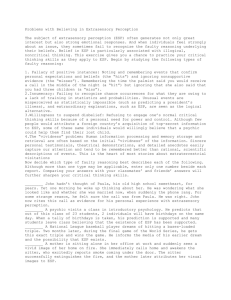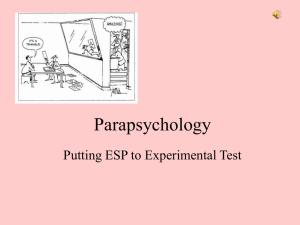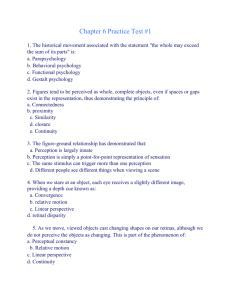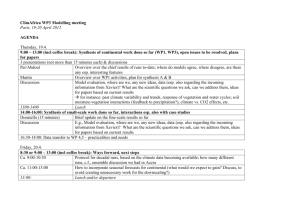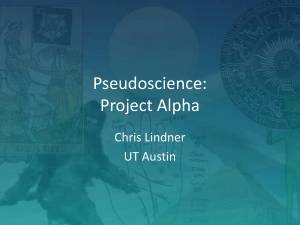ESP—Perception Without Sensation?
advertisement
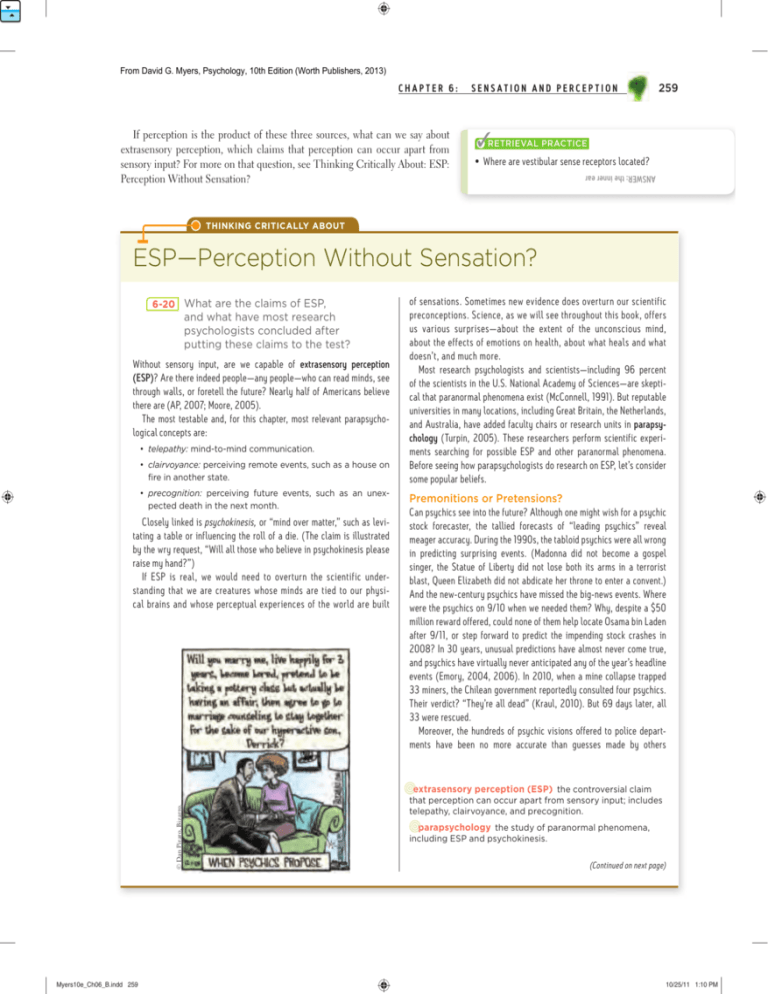
From David G. Myers, Psychology, 10th Edition (Worth Publishers, 2013) If perception is the product of these three sources, what can we say about extrasensory perception, which claims that perception can occur apart from sensory input? For more on that question, see Thinking Critically About: ESP: Perception Without Sensation? S E N S AT I O N A N D P E R C E P T I O N 259 ✓RETRIEVAL PRACTICE • Where are vestibular sense receptors located? ANSWER: the inner ear CHAPTER 6: THINKING CRITICALLY ABOUT ESP—Perception Without Sensation? 6-20 What are the claims of ESP, and what have most research psychologists concluded after putting these claims to the test? Without sensory input, are we capable of extrasensory perception (ESP)? Are there indeed people—any people—who can read minds, see through walls, or foretell the future? Nearly half of Americans believe there are (AP, 2007; Moore, 2005). The most testable and, for this chapter, most relevant parapsychological concepts are: • telepathy: mind-to-mind communication. • clairvoyance: perceiving remote events, such as a house on fire in another state. • precognition: perceiving future events, such as an unexpected death in the next month. © Dan Piraro, Bizarro. Closely linked is psychokinesis, or “mind over matter,” such as levitating a table or influencing the roll of a die. (The claim is illustrated by the wry request, “Will all those who believe in psychokinesis please raise my hand?”) If ESP is real, we would need to overturn the scientific understanding that we are creatures whose minds are tied to our physical brains and whose perceptual experiences of the world are built Myers10e_Ch06_B.indd 259 of sensations. Sometimes new evidence does overturn our scientific preconceptions. Science, as we will see throughout this book, offers us various surprises—about the extent of the unconscious mind, about the effects of emotions on health, about what heals and what doesn’t, and much more. Most research psychologists and scientists—including 96 percent of the scientists in the U.S. National Academy of Sciences—are skeptical that paranormal phenomena exist (McConnell, 1991). But reputable universities in many locations, including Great Britain, the Netherlands, and Australia, have added faculty chairs or research units in parapsychology (Turpin, 2005). These researchers perform scientific experiments searching for possible ESP and other paranormal phenomena. Before seeing how parapsychologists do research on ESP, let’s consider some popular beliefs. Premonitions or Pretensions? Can psychics see into the future? Although one might wish for a psychic stock forecaster, the tallied forecasts of “leading psychics” reveal meager accuracy. During the 1990s, the tabloid psychics were all wrong in predicting surprising events. (Madonna did not become a gospel singer, the Statue of Liberty did not lose both its arms in a terrorist blast, Queen Elizabeth did not abdicate her throne to enter a convent.) And the new-century psychics have missed the big-news events. Where were the psychics on 9/10 when we needed them? Why, despite a $50 million reward offered, could none of them help locate Osama bin Laden after 9/11, or step forward to predict the impending stock crashes in 2008? In 30 years, unusual predictions have almost never come true, and psychics have virtually never anticipated any of the year’s headline events (Emory, 2004, 2006). In 2010, when a mine collapse trapped 33 miners, the Chilean government reportedly consulted four psychics. Their verdict? “They’re all dead” (Kraul, 2010). But 69 days later, all 33 were rescued. Moreover, the hundreds of psychic visions offered to police departments have been no more accurate than guesses made by others extrasensory perception (ESP) the controversial claim that perception can occur apart from sensory input; includes telepathy, clairvoyance, and precognition. parapsychology the study of paranormal phenomena, including ESP and psychokinesis. (Continued on next page) 10/25/11 1:10 PM From David G. Myers, Psychology, 10th Edition (Worth Publishers, 2013) 260 CHAPTER 6: S E N S AT I O N A N D P E R C E P T I O N (Nickell, 1994, 2005; Radford, 2010; Reiser, 1982). But their sheer volume does increase the odds of an occasional correct guess, which psychics can then report to the media. Police departments are wise to all this. When researchers asked the police departments of America’s 50 largest cities whether they ever had used psychics, 65 percent said No (Sweat & Durm, 1993). Of those that had, not one had found them helpful. Vague predictions can also later be interpreted (“retrofitted”) to match events that provide a perceptual set for “understanding” them. Nostradamus, a sixteenth-century French psychic, explained in an unguarded moment that his ambiguous prophecies “could not possibly be understood till they were interpreted after the event and by it.” Are the spontaneous “visions” of everyday people any more accurate? Do dreams, for example, foretell the future, as people from both Eastern and Western cultures tend to believe—making some people more reluctant to fly after dreaming of a plane crash (Morewedge & Norton, 2009)? Or do they only seem to do so when we recall or reconstruct them in light of what has already happened? Two Harvard psychologists tested the prophetic power of dreams after superhero aviator Charles Lindbergh’s baby son was kidnapped and murdered in 1932, but before the body was discovered (Murray & Wheeler, 1937). When invited to report their dreams about the child, 1300 visionaries submitted dream reports. How many accurately envisioned the child dead? Five percent. And how many also correctly anticipated the body’s location—buried among trees? Only 4 of the 1300. Although this number was surely no better than chance, to those 4 dreamers the accuracy of their apparent precognitions must have seemed uncanny. Given the billions of events in the world each day, and given enough days, some stunning coincidences are sure to occur. By one careful estimate, chance alone would predict that more than a thousand times a day someone on Earth will think of another person and then within the next five minutes will learn of that person’s death (Charpak & Broch, 2004). Thus, when explaining an astonishing event, we should “give chance a chance” (Lilienfeld, 2009). With enough time and people, the improbable becomes inevitable. Putting ESP to Experimental Test When faced with claims of mind reading or out-of-body travel or communication with the dead, how can we separate bizarre ideas from those that sound bizarre but are true? At the heart of science is a simple answer: Test them to see if they work. If they do, so much the better for the ideas. If they don’t, so much the better for our skepticism. This scientific attitude has led both believers and skeptics to agree that what parapsychology needs is a reproducible phenomenon and a theory to explain it. Parapsychologist Rhea White (1998) spoke for many in saying that “the image of parapsychology that comes to my mind, based on nearly 44 years in the field, is that of a small airplane [that] has been perpetually taxiing down the runway of the Empirical Science Airport since 1882 . . . its movement punctuated occasionally by lifting a few feet off the ground only to bump back down on the tarmac once again. It has never taken off for any sustained flight.” How might we test ESP claims in a controlled, reproducible experiment? An experiment differs from a staged demonstration. In the laboratory, the experimenter controls what the “psychic” sees and hears. On stage, the psychic controls what the audience sees and hears. The search for a valid and reliable test of ESP has resulted in thousands of experiments. After digesting data from 30 such studies, parapsychologists Lance Storm and his colleagues (2010a,b) concluded that, given participants with experience or belief in ESP, there is “consistent and reliable” parapsychological evidence. Psychologist Ray Hyman (2010), who has been scrutinizing parapsychological research since 1957, replies that if this is the best evidence, it fails to impress: “Parapsychology will achieve scientific acceptability only when it “A the “At h hheart off science i iis an essential i l tension i bbetween two seemingly contradictory attitudes—an openness to new ideas, no matter how bizarre or counterintuitive they may be, and the most ruthless skeptical scrutiny of all ideas, old and new.” Carl Sagan (1987) “T be “To b sure off hitting hi i the h target, shoot h first fi andd call ll whatever h you hit the target.” “A person who talks a lot is sometimes right.” Magician Harry Houdini after fooling Sir Arthur Conan Doyle with a pseudo-psychic trick: “Now I beg of you, Sir Arthur, do not jump to the conclusion that certain things you see are necessarily ‘supernatural,’ or with the work of ‘spirits,’ just because you cannot explain them.” Spanish proverb Quoted by William Kalush and Larry Sloman, The Secret Life of Houdini, 2007 Writer-artist Ashleigh Brilliant, 1933– *** To feel awe, mystery, and a deep reverence for life, we need look no further than our own perceptual system and its capacity for organizing formless nerve impulses into colorful sights, vivid sounds, and evocative smells. As Shakespeare’s Hamlet recognized, “There are Myers10e_Ch06_B.indd 260 10/25/11 1:11 PM From David G. Myers, Psychology, 10th Edition (Worth Publishers, 2013) Testing psychic powers in the British population Hertfordshire University psychologist Richard Wiseman created a “mind machine” to see if people can influence or predict a coin toss. Using a touch-sensitive screen, visitors to festivals around the country were given four attempts to call heads or tails. Using a random-number generator, a computer then decided the outcome. When the experiment concluded in January 2000, nearly 28,000 people had predicted 110,972 tosses—with 49.8 percent correct. provides a positive theory with . . . independently replicable evidence. This is something it has yet to achieve after more than a century.” Daryl Bem (2011), a respected social psychologist, has been a skeptic of stage psychics; he once quipped that “a psychic is an actor playing the role of a psychic” (1984). Yet he has reignited hopes for replicable evidence with nine experiments that seemed to show people anticipating future events. In one, when an erotic scene was about to appear on a screen in one of two randomly selected positions, Cornell University participants guessed right 53.1 percent of the time (beating 50 percent by a small but statistically significant margin). In another, people viewed a set of words, took a recall test of those words, and then rehearsed a randomly selected subset of those words. People better remembered the rehearsed words—even when the rehearsal took place after the recall test. The upcoming rehearsal—a future event—apparently affected their ability to recall words. S E N S AT I O N A N D P E R C E P T I O N 261 Bem wonders if his “anomalous” findings reflect an evolutionary advantage to those who can precognitively anticipate future dangers. Critics scoff. “If any of his claims were true,” wrote cognitive scientist Douglas Hofstadter (2011), “then all of the bases underlying contemporary science would be toppled, and we would have to rethink everything about the nature of the universe.” Moreover, if future events retroactively affect present feelings, then why can’t people intuitively predict casino outcomes or stock market futures? Despite the paper having survived critical reviews by a top-tier journal, other critics found the methods “badly flawed” (Alcock, 2011) or the statistical analyses “biased” (Wagenmakers et al., 2011). “A result—especially one of this importance—must recur several times in tests by independent and skeptical researchers to gain scientific credibility,” observed astronomer David Helfand (2011). “I have little doubt that Professor Bem’s experiments will fail this test.” Anticipating such skepticism, Bem has made his computer materials available to anyone who wishes to replicate his studies, and replications are now under way. One research team has already conducted five replications of Bem’s recall experiments at various universities and found no precognition (Galak et al., 2011). Regardless of the outcomes, science will have done its work. It will have been open to a finding that challenges its own worldview, and then, through follow-up research, it will have assessed its validity. And that is how science sifts crazy-sounding ideas, leaving most on the historical waste heap while occasionally surprising us. One skeptic, magician James Randi, had a longstanding offer (which expired in 2010) of $1 million to be given “to anyone who proves a genuine psychic power under proper observing conditions” (Randi, 1999; Thompson, 2010). French, Australian, and Indian groups have made similar offers of up to 200,000 euros (CFI, 2003). Large as these sums are, the scientific seal of approval would be worth far more. To refute those who say there is no ESP, one need only produce a single person who can demonstrate a single, reproducible ESP event. (To refute those who say pigs can’t talk would take but one talking pig.) So far, no such person has emerged. ✓RETRIEVAL PRACTICE • What is the field of study that researches claims of extrasensory perception (ESP)? ANSWER: parapsychology Courtesy of Claire Cole CHAPTER 6: more things in Heaven and Earth, Horatio, than are dreamt of in your philosophy.” Within our ordinary sensory and perceptual experiences lies much that is truly extraordinary— surely much more than has so far been dreamt of in our psychology. Myers10e_Ch06_B.indd 261 10/25/11 1:11 PM
